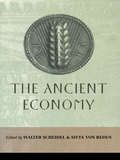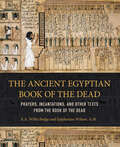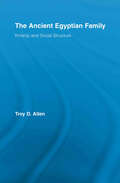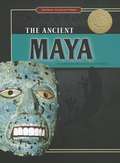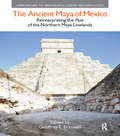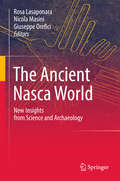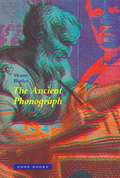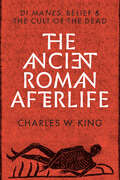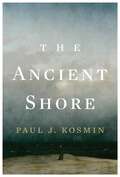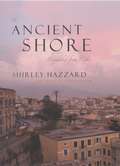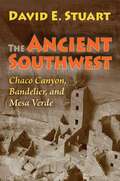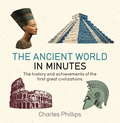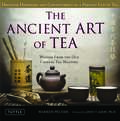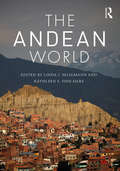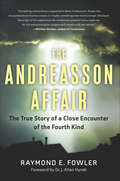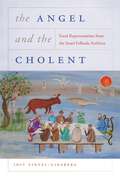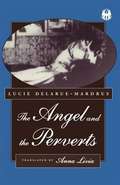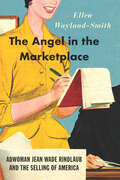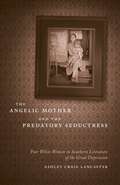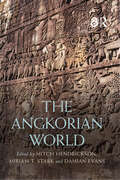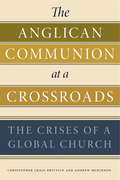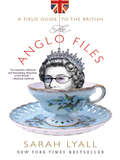- Table View
- List View
The Ancient Economy (Edinburgh Readings On The Ancient World Ser.)
by Walter Scheidel Sitta von RedenThe Ancient Economy introduces readers to the nature of economic life in the ancient world, and provides a valuable guide to scholarly debates on the subject. The book describes and examines the economic processes and fluctuations of the ancient world, and shows how these relate to political and social change and conditions. Leading experts address the central issues, from agricultural production to the uses of money and the creation of markets. Taken as a whole the book exemplifies the range of interdisciplinary perspectives on the ancient economy, and illustrates the methodological approaches scholars have deployed to understand it. In doing so it draws on literary, ecological and archaeological evidence.
The Ancient Egyptian Book of the Dead: Prayers, Incantations, and Other Texts from the Book of the Dead
by E. A. Budge Epiphanius WilsonEasy-to-understand sections help you discover the magic of ancient Egypt in this comprehensive translation of the real Egyptian Book of the Dead.The Ancient Egyptian Book of the Dead is a compendium of classic texts by one of the greatest translators and historians of ancient Egypt, as well as one of the most renowned Egyptologists of all time, E. A. Wallis Budge.In Part I, using plain, simple, easy-to-understand language, Budge delves into the history, instructions, motifs, themes, spells, incantations, and charms written for the dead that ancient Egyptians would need to employ to pass from this world into the next. Throughout centuries, these “books of the dead man” were often found buried alongside mummies and inside tombs, which locals and grave robbers would collect.In Part II, Budge’s classic translation of the Book of the Dead from the Papyrus of Ani (and others) is presented in its original format and contains the prayers, incantations, and ancient text used to help guide the dead during their journey.Finally, in Part III, a list of Egyptian deities is provided. Illustrated throughout with great care, including photos, fine art, and other illustrations, this edition will bring the historic afterlife guide back to life.
The Ancient Egyptian Family: Kinship and Social Structure (African Studies)
by Troy D. AllenScholars in Egyptology have often debated the following question: was the ancient Egyptian society organized along patrilineal or matrilineal lines? In taking a fresh and innovative look at the ancient Egyptian family, Allen attempts to solve this long-standing puzzle. Allen argues that the matrilineal nature of the ancient Egyptian family and social organization provides us with the key to understanding why and how ancient Egyptian women were able to rise to power, study medicine, and enjoy basic freedoms that did not emerge in Western Civilization until the twentieth century. More importantly, by examining the types of families that existed in ancient Egypt along with highlighting the ancient Egyptians' kinship terms, we can place the ancient Egyptian civilization in the cultural context and incubator of Black Africa. This groundbreaking text is a must-read for Historians and those working in African Studies and Egyptology.
The Ancient Maya (Exploring the Ancient World)
by Jennifer Fretland VanVoorstThe civilization of the ancient Maya reached its peak about 2,000 years ago. The Maya held a complex religious view of the world. In an effort to maintain order by pleasing their many gods, they built imposing stone temples, developed a written language, and played a ball game with life-or-death consequences.
The Ancient Maya of Mexico: Reinterpreting the Past of the Northern Maya Lowlands (Approaches To Anthropological Archaeology Ser.)
by Geoffrey E. BraswellThe archaeological sites of Mexico's Yucatan peninsula are among the most visited ancient cities of the Americas. Archaeologists have recently made great advances in our understanding of the social and political milieu of the northern Maya lowlands. However, such advances have been under-represented in both scholarly and popular literature until now. 'The Ancient Maya of Mexico' presents the results of new and important archaeological, epigraphic, and art historical research in the Mexican states of Yucatan, Campeche, and Quintana Roo. Ranging across the Middle Preclassic to the Modern periods, the volume explores how new archaeological data has transformed our understanding of Maya history. 'The Ancient Maya of Mexico' will be invaluable to students and scholars of archaeology and anthropology, and all those interested in the society, rituals and economic organisation of the Maya region.
The Ancient Nasca World
by Nicola Masini Rosa Lasaponara Giuseppe OreficiThis book presents outstanding chapter contributions on the Nasca culture in a variety of artistic expressions such as architecture, geoglyphs, ceramics, music, and textiles. The approach, based on the integration of science with archaeology and anthropology, sheds new light on the Nasca civilization. In particular the multidisciplinary character of the contributions and earth observation technologies provide new information on geoglyphs, the monumental ceremonial architecture of Cahuachi, and the adaptation strategies in the Nasca desert by means of sophisticated and effective aqueduct systems. Finally, archaeological looting and vandalism are covered. This book will be of interest to students, archaeologists, historians, scholars of Andean civilizations, scientists in physical anthropology, remote sensing, geophysics, and cultural heritage management.
The Ancient Phonograph
by Shane ButlerLong before the invention of musical notation, and long before that of the phonograph, the written word was unrivaled as a medium of the human voice. In The Ancient Phonograph, Shane Butler searches for traces of voices before Edison, reconstructing a series of ancient soundscapes from Aristotle to Augustine. Here the real voices of tragic actors, ambitious orators, and singing emperors blend with the imagined voices of lovesick nymphs, tormented heroes, and angry gods. The resonant world we encounter in ancient sources is at first unfamiliar, populated by texts that speak and sing, often with no clear difference between the two. But Butler discovers a commonality that invites a deeper understanding of why voices mattered then and why they have mattered since. With later examples that range from Mozart to Jimi Hendrix, Butler offers an ambitious attempt to rethink the voice -- as an anatomical presence, a conceptual category, and a source of pleasure and wonder. He carefully and critically assesses the strengths and limits of recent theoretical approaches to the voice by Adriana Cavarero and Mladen Dolar and makes a rich and provocative range of ancient material available for the first time. The Ancient Phonograph will appeal not only to classicists and to voice theorists but to anyone with an interest in the verbal arts -- literature, oratory, song -- and the nature of aesthetic experience.
The Ancient Roman Afterlife: Di Manes, Belief, and the Cult of the Dead
by Charles W. KingA comprehensive study of the manes, their worship, and their place in Roman conceptions of their society.In ancient Rome, it was believed some humans were transformed into special, empowered beings after death. These deified dead, known as the manes, watched over and protected their surviving family members, possibly even extending those relatives&’ lives. But unlike the Greek hero-cult, the worship of dead emperors, or the Christian saints, the manes were incredibly inclusive—enrolling even those without social clout, such as women and the poor, among Rome&’s deities. The Roman afterlife promised posthumous power in the world of the living.While the manes have often been glossed over in studies of Roman religion, this book brings their compelling story to the forefront, exploring their myriad forms and how their worship played out in the context of Roman religion&’s daily practice. Exploring the place of the manes in Roman society, Charles King delves into Roman beliefs about their powers to sustain life and bring death to individuals or armies, examines the rituals the Romans performed to honor them, and reclaims the vital role the manes played in the ancient Roman afterlife.&“King ranges widely across literary genres, law, epigraphy, and archaeology. He provides a thorough, rigorous, and well-documented study of an aspect of Roman religion and culture that, despite its importance, has so far not received due attention.&” —James B. Rives, author of Religion in the Roman Empire&“Groundbreaking . . . An invaluable resource for scholars of religion, funerary practice and afterlife in ancient Rome and more generally . . . King aims to use his model of variability in Roman belief to show the cult of the dead as inclusive of all Romans, living and deceased. Through extensive literary evidence and select cross-cultural comparisons, he largely succeeds. This stands to become a foundational text.&” —Antiquity&“King presents many attractive impressions of Roman society in his study . . . King&’s major thesis—that Romans regarded their dead as gods, thought about them, communicated with them, attended to them, and intended to join them—is conclusively presented.&” —Bryn Mawr Classical Review
The Ancient Shore
by Paul J. KosminAn esteemed historian explores the natural and social dynamics of the ancient coastline, demonstrating for the first time its integral place in the world of Mediterranean antiquity.As we learn from The Odyssey and the Argonauts, Greek dramas frequently played out on a watery stage. In particular, antiquity’s key events and exchanges often occurred on coastlines. Yet the shore was not just a site of conquest and trade, ire and yearning. The seacoast was a singular kind of space and was integral to the cosmology of the Greeks and their neighbors. In The Ancient Shore, award-winning historian Paul Kosmin reveals the influence of the coast on the inner lives of the ancients: their political thought, scientific notions, artistic endeavors, and myths; their sense of wonder and of self.The Ancient Shore transports readers to a time when the coast was an unpredictable, formidable site of infinite and humbling possibility. Shorelines served as points of connection and competition that fostered distinctive political identities. It was at the coast—ever violent, ever permeable to predation—that state power ended, and so the coast was fundamental to theories of sovereignty. Then too, the boundary of land and sea symbolized human limitation, making it the subject of elaborate and continuous philosophical, scientific, and religious attention.Kosmin’s ancient world is expansive, connecting the Atlantic to the Straits of Malacca, the Black Sea to the Indian Ocean. And his methods are similarly far-ranging, integrating accounts of statecraft and commerce with intellectual, literary, religious, and environmental history. The Ancient Shore is a radically new encounter with people, places, objects, and ideas we thought we knew.
The Ancient Shore: Dispatches from Naples
by Shirley Hazzard Francis SteegmullerFor Hazzard and her husband, both insatiable readers, the Naples of Pliny, Gibbon, and Auden is constantly alive to them in the present. And in "The Ancient Shore", Hazzard is our guide, as we encounter Henry James, Oscar Wilde, and of course Goethe, but her concern is primarily with the Naples of our own time -- often violently unforgiving to innocent tourists, but able to transport the visitor who attends patiently to its rhythms and history. A town shadowed by both the symbol and the reality of Vesuvius can never fail to acknowledge the essential precariousness of life -- nor, as the lover of Naples discovers, the human compassion, generosity, and friendship that are necessary to sustain it.
The Ancient Southwest: Chaco Canyon, Bandelier, and Mesa Verde. Revised edition.
by David E. StuartOver twenty-five years ago, David Stuart began writing award-winning newspaper articles on regional archaeology that appealed to general readers. These columns shared interesting, and usually little-known, facts and stories about the ancient people and places of the Southwest. By 1985, Stuart had penned enough columns to fill a book, Glimpses of the Ancient Southwest, which has been unavailable for years. Now he has rewritten most of his original articles to include recently discovered information about Chaco Canyon, Bandelier, and Mesa Verde. Stuart's unusual perspective focuses on both the past and the present: Want to know why gasoline now costs $4.00 a gallon, and is headed higher, yet we have no instant solution? Chacoan, Roman, even Egyptian archaeology all provide elemental answers. The Ancient Southwest shares those with us.
The Ancient World in Minutes (IN MINUTES)
by Charles PhillipsClear, concise yet wide-ranging, The Ancient World in Minutes is the quickest way to understand the great civilizations of the distant past. From the first-ever cities of Sumeria and Babylon around 3500 BCE to the fall of Rome and the bloody demise of the Aztecs, here - in 200 mini-essays - are the critical leaders and wars; ideas and inventions; myths and religions; and art and architecture of the first 5000 years of recorded history. Discover the spiritual, cultural, technological and artistic innovations of the ancient civilizations that still amaze and influence us today - from the Pyramids and Parthenon to Machu Picchu and the Great Wall of China; and from the first hieroglyphic writings and great epics of world literature to democracy and the Olympic Games. The great civilizations are brought to life in vivid illustrations with 200 maps, iconic artworks and ancient artefacts. Contents include Mesopotamia, Ancient Egypt, Ancient India, Ancient China, The Persian Empire, Classic Greece, The Roman Republic, the Maya, The Inca and many more.
The Ancient art of Tea
by John T. Kirby Warren Peltier"It is my hope that this book will encourage others in the West to pick up where the ancients and the author left off and go out and search for sources of sweet water here in North America. ... It is time for us to pick up the mantle and spread the word, Tea."--Dr. Eric Messersmith, Institute for Asian Studies, Florida International UniversityThe health benefits of tea, from green teas to white, oolong and black teas, are well known in our world today. How to create the perfect, healthy cup of tea is a process few people truly understand, making The Ancient Art of Tea a needed guide for tea lovers.Making a perfect cup of tea is a dynamic process that requires the right environment, good spring water, a suitable fire to boil water, skill in steeping tea, and deep understanding of tea connoisseurship. The Ancient Art of Tea teaches the two fundamental secrets to tea as practiced in ancient China--technique and taste. With this beautiful volume, you will be able to enhance and thoroughly immerse yourself in the tea experience.
The Andean World (Routledge Worlds)
by Linda J. Seligmann Kathleen S. Fine-DareThis comprehensive reference offers an authoritative overview of Andean lifeways. It provides valuable historical context, and demonstrates the relevance of learning about the Andes in light of contemporary events and debates. The volume covers the ecology and pre-Columbian history of the region, and addresses key themes such as cosmology, aesthetics, gender and household relations, modes of economic production, exchange, and consumption, postcolonial legacies, identities, political organization and movements, and transnational interconnections. With over 40 essays by expert contributors that highlight the breadth and depth of Andean worlds, this is an essential resource for students and scholars alike.
The Andreasson Affair: The True Story of a Close Encounter of the Fourth Kind
by Raymond E. FowlerThis examination of a case of alien abduction “will captivate, bother, intrigue, and even frighten as one . . . contemplates its implications” (Dr. J. Allen Hynek, founder, Center for UFO Studies (CUFOS) Reviews).The Andreasson Affair is more than just a classic example of a close encounter. It is—to use the jargon of ufologists—a case of such “high strangeness” that even the most open-minded investigators were at first inclined to dismiss it out of hand. Yet it has become probably the best documented case of its kind to date, the subject of an intensive 12-month investigation conducted for the Center for UFO Studies (CUFOS) that involved, among other things, the recording of large quantities of testimony given under hypnosis, extensive lie detector testing of witnesses, detailed analysis of corroborative circumstantial evidence, exhaustive comparison with other such accounts, and much more.The Andreasson Affair includes:The most detailed description of any UFO abduction experience.Betty’s precise drawings of her experience.A supporting foreword to the book by astronomer Dr. J. Allen Hynek.Verification of all events associated with Betty’s experience.This new edition contains a new afterword for a new generation“Something extraordinary happened to Betty Andreasson. Maybe she encountered non-human visitors or maybe something even more strange. Whatever the origin of her experience, her immensely powerful story awed me. Its rich and provocative imagery will remain with me forever.” —Whitley Strieber, author of Communion
The Angel and the Cholent: Food Representation from the Israel Folktale Archives (Raphael Patai Series in Jewish Folklore and Anthropology)
by Idit Pintel-GinsbergThe Angel and the Cholent: Food Representation from the Israel Folktale Archives by Idit Pintel-Ginsberg, translated into English for the first time from Hebrew, analyzes how food and foodways are the major agents generating the plots of several significant folktales. The tales were chosen from the Israel Folktales Archives’ (IFA) extensive collection of twenty-five thousand tales. In looking at the subject of food through the lens of the folktale, we are invited to consider these tales both as a reflection of society and as an art form that discloses hidden hopes and often subversive meanings. The Angel and the Cholent presents thirty folktales from seventeen different ethnicities and is divided into five chapters. Chapter 1 considers food and taste—tales included here focus on the pleasure derived by food consumption and its reasonable limits. The tales in Chapter 2 are concerned with food and gender, highlighting the various and intricate ways food is used to emphasize gender functions in society, the struggle between the sexes, and the love and lust demonstrated through food preparations and its consumption. Chapter 3 examines food and class with tales that reflect on how sharing food to support those in need is a universal social act considered a "mitzvah" (a Jewish religious obligation), but it can also become an unspoken burden for the providers. Chapter 4 deals with food and kashrut—the tales included in this chapter expose the various challenges of "keeping kosher," mainly the heavy financial burden it causes and the social price paid by the inability of sharing meals with non-Jews. Finally, Chapter 5 explores food and sacred time, with tales that convey the tension and stress caused by finding and cooking specific foods required for holiday feasts, the Shabbat and other sacred times. The tales themselves can be appreciated for their literary quality, humor, and profound wisdom. Readers, scholars, and students interested in folkloristic and anthropological foodway studies or Jewish cultural studies will delight in these tales and find the editorial commentary illuminating.
The Angel and the Perverts
by Lucie Delarue-Mardrus Anna LiviaFirst published in 1930. Set in the lesbian and gay circles of Paris in the 1920s, The Angel and the Perverts tells the story of a hermaphrodite born to upper class parents in Normandy and ignorant of his/her physical difference. As an adult, s/he lives a double life as Marion/Mario, passing undetected as a lesbian in the literary salons of the times, and as a gay man in the cocaine dens made famous by Colette.
The Angel in the Marketplace: Adwoman Jean Wade Rindlaub and the Selling of America
by Ellen Wayland-SmithThe popular image of a midcentury adwoman is of a feisty girl beating men at their own game, a female Horatio Alger protagonist battling her way through the sexist workplace. But before the fictional rise of Peggy Olson or the real-life stories of Patricia Tierney and Jane Maas came Jean Wade Rindlaub: a female power broker who used her considerable success in the workplace to encourage other women—to stick to their kitchens. The Angel in the Marketplace is the story of one of America’s most accomplished advertising executives. It is also the story of how advertisers like Rindlaub sold a postwar American dream of capitalism and a Christian corporate order. Rindlaub was responsible for award-winning, mega sales-generating advertisements for all things domestic, including Oneida silverware, Betty Crocker cake mix, Campbell’s soup, and Chiquita bananas. Her success largely came from embracing, rather than subverting, the cultural expectations of women. She believed her responsibility as an advertiser was not to spring women from their trap, but to make that trap more comfortable. Rindlaub wasn’t just selling silverware and cakes; she was selling the virtues of free enterprise. By following the arc of Rindlaub’s career from the 1920s through the 1960s, we witness how a range of cultural narratives—advertising chief among them—worked powerfully to shape women’s emotional and economic behavior in support of the free market system. Alongside Rindlaub’s story, Ellen Wayland-Smith provides a riveting history of how women were repeatedly sold the idea that their role as housewives was more powerful, and more patriotic, than any outside the home. And by buying into the image of morality through an unregulated market, many of these women helped fuel backlash against economic regulation and socialization efforts throughout the twentieth century. The Angel in the Marketplace is a nuanced portrayal of a complex woman, one who both shaped and reflected the complicated cultural, political, and religious forces defining femininity in America at mid-century. This compelling account of one of advertising’s most fervent believers is a tale of a Mad Woman we haven’t been told.
The Angelic Mother and the Predatory Seductress: Poor White Women in Southern Literature of the Great Depression (Southern Literary Studies)
by Ashley Craig LancasterIn The Angelic Mother and the Predatory Seductress, Ashley Craig Lancaster examines how converging political and cultural movements helped to create dualistic images of southern poor white female characters in Depression-era literature. While other studies address the familial and labor issues that challenged female literary characters during the 1930s, Lancaster focuses on how the evolving eugenics movement reinforced the dichotomy of altruistic maternal figures and destructive sexual deviants. According to Lancaster, these binary stereotypes became a new analogy for hope and despair in America's future and were well utilized by Depression-era politicians and authors to stabilize the country's economic decline. As a result, the complexity of women's lives was often overlooked in favor of stock characters incapable of individuality. Lancaster studies a variety of works, including those by male authors William Faulkner, Erskine Caldwell, and John Steinbeck, as well as female novelists Mary Heaton Vorse, Myra Page, Grace Lumpkin, and Olive Tilford Dargan. She identifies female stereotypes in classics such as To Kill a Mockingbird and in the work of later writers Dorothy Allison and Rick Bragg, who embrace and share in a poor white background.The Angelic Mother and the Predatory Seductress reveals that these literary stereotypes continue to influence not only society's perception of poor white southern women but also women's perception of themselves.
The Angkorian World (Routledge Worlds)
by Miriam T. Stark Mitch Hendrickson Damian EvansThe Angkorian World explores the history of Southeast Asia’s largest ancient state from the first to mid-second millennium CE. Chapters by leading scholars combine evidence from archaeology, texts, and the natural sciences to introduce the Angkorian state, describe its structure, and explain its persistence over more than six centuries. Comprehensive and accessible, this book will be an indispensable resource for anyone studying premodern Asia. The volume’s first of six sections provides historical and environmental contexts and discusses data sources and the nature of knowledge production. The next three sections examine the anthropogenic landscapes of Angkor (agrarian, urban, and hydraulic), the state institutions that shaped the Angkorian state, and the economic foundations on which Angkor operated. Part V explores Angkorian ideologies and realities, from religion and nation to identity. The volume’s last part reviews political and aesthetic Angkorian legacies in an effort to explain why the idea of Angkor remains central to its Cambodian descendants. Maps, graphics, and photographs guide readers through the content of each chapter. Chapters in this volume synthesise more than a century of work at Angkor and in the regions it influenced. The Angkorian World will satisfy students, researchers, academics, and the knowledgeable layperson who seeks to understand how this great Angkorian Empire arose and functioned in the premodern world.
The Anglican Communion at a Crossroads: The Crises of a Global Church
by Christopher Craig Brittain Andrew McKinnonWorldwide debates over issues of sexuality and gender have come to a head in recent years in mainline and evangelical churches, with the Anglican Communion—a worldwide network of churches that trace their practice to Canterbury and claim some 85 million members—among the most publicly visible sites of contestation. This thorough and compelling analysis of the conflicts within the Communion argues that they are symptoms of long-simmering issues that must be addressed when Anglican bishops and archbishops meet at the 2020 Lambeth Conference.To many, the disagreements over such issues as LGBTQ clergy, same-sex marriage, and women’s ordination suggest an insurmountable crisis facing Anglicans, one that may ultimately end the Communion. Christopher Craig Brittain and Andrew McKinnon argue otherwise. Drawing on extensive empirical research and interviews with influential Anglican leaders, they show how these struggles stem from a complex interplay of factors, notably the forces and effects of globalization, new communications technology, and previous decisions made by the Communion. In clarifying both the theological arguments and social forces at play as the bishops and primates of the Anglican Communion prepare to set the Church’s course for the next decade, Brittain and McKinnon combine sociological and theological methodologies to provide both a nuanced portrait of Anglicanism in a transnational age and a primer on the issues with which the Lambeth Conference will wrestle.Insightful, informative, and thought-provoking, The Anglican Communion at a Crossroads is an invaluable resource for understanding the debates taking place in this worldwide community. Those interested in Anglicanism, sexuality and the Christian tradition, the sociology of religion, and the evolving relationship between World Christianity and churches in the Global North will find it indispensable.
The Anglo Files: A Field Guide To The British
by Sarah LyallNew York Times Bestseller “An exquisite, hilarious and devastating dissection.” —Malcolm Gladwell Why do the English keep apologizing? Why are they so unenthusiastic about enthusiasm? Why does rain surprise them? When are they being ironic, and how can you tell? Even after eighteen years in London, New York Times reporter Sarah Lyall remained perplexed and intrigued by its curious inhabitants and their curious customs. She’s since returned to the United States, but this distillation of incisive—and irreverent—insights, now updated with a new preface, is just as illuminating today. And perhaps even more so, in the wake of Brexit and the attendant national identity crisis. While there may be no easy answer to the question of how, exactly, to understand the English, The Anglo Files—part anthropological field study, part memoir—helps point the way.
The Anglo Files: A Field Guide to the British
by Sarah LyallDispatches from the new Britain: a slyly funny and compulsively readable portrait of a nation finally refurbished for the twenty-first century. Sarah Lyall, a reporter for the New York Times, moved to London in the mid-1990s and soon became known for her amusing and incisive dispatches on her adopted country. As she came to terms with its eccentric inhabitants (the English husband who never turned on the lights, the legislators who behaved like drunken frat boys, the hedgehog lovers, the people who extracted their own teeth), she found that she had a ringside seat at a singular transitional era in British life. The roller-coaster decade of Tony Blair's New Labor government was an increasingly materialistic time when old-world symbols of aristocratic privilege and stiff-upper-lip sensibility collided with modern consumerism, overwrought emotion, and a new (but still unsuccessful) effort to make the trains run on time. Appearing a half-century after Nancy Mitford's classic, Noblesse Oblige, Lyall's book is a brilliantly witty account of twenty-first-century Britain that will be recognized as a contemporary classic. "The Anglo Files should be handed out, as a public service, in the immigration line at Heathrow." -Malcolm Gladwell, author of "Blink." "When Sarah Lyall married an Englishman and moved to London ten years ago, few around her realized she was a modern-day Tocqueville otherwise they would have been much more guarded. The happy result is The Anglo Files, a razor-sharp, hilarious, wickedly insightful, decidedly biased account of Everything British." -Graydon Carter, editor of Vanity Fair
The Anglo Files: A Field Guide to the British
by Sarah Lyall"Should be handed out . . . in the immigration line at Heathrow." --Malcolm Gladwell Sarah Lyall moved to London in the mid-1990s and soon became known for amusing and sharp dispatches on her adopted country. Confronted by the eccentricities of these island people (the English husband who never turned on the lights, the legislators who behaved like drunken frat boys, the hedgehog lovers), she set about trying to figure out the British. Part anthropological field study and part memoir, The Anglo Files has already received great acclaim and recognition for the astuteness, humor, and sensitivity with which the author wields her pen.
